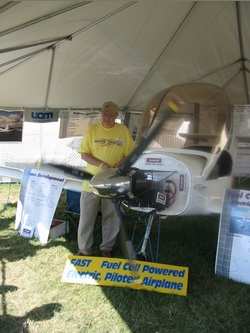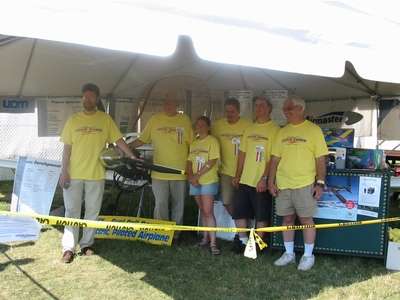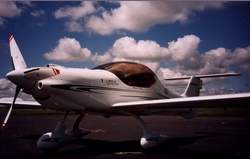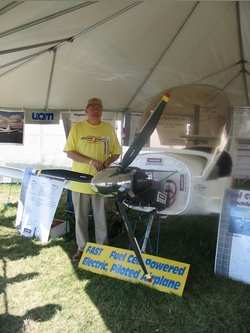Can You Hear Me Now?
By ANN Contributor Pete Combs
 If James Dunn has his way, you won't hear much of
the next big thing in aviation. It'll come quietly, heralded only
by the whir of a propeller and the whoosh of an airframe
slipping through the sky.
If James Dunn has his way, you won't hear much of
the next big thing in aviation. It'll come quietly, heralded only
by the whir of a propeller and the whoosh of an airframe
slipping through the sky.
Dunn, President of Advanced Technology Products in Worcester,
Massachusetts, is also the executive director of FASTec, the
Foundation for Advancing Science and Technology Education
Curriculum. His dream is to power aviation with hydrogen
fuel-cells.
 "The
technology is already out there," says Dunn. "By the year 2006,
four of the biggest auto manufacturers will have introduced
fuel-cell cars. By 2008, it'll be affordable."
"The
technology is already out there," says Dunn. "By the year 2006,
four of the biggest auto manufacturers will have introduced
fuel-cell cars. By 2008, it'll be affordable."
Affordability is the key to making his fuel-cell flyer work.
It's a four-phase project, with the prototype introduced here at
the EAA fly-in this week. The electric airplane, dubbed the
"E-Plane," is built on the frame of a high-speed, all-carbon French
DynAero Lafayette III, donated to FASTec by American Ghiles
Aircraft in Dijon, France. The motor was donated by UQM
Technologies of Golden, Colorado. The prop comes from New Zealand,
a donation from Airmaster Propellers. The batteries were sent free
of charge from Lithium Technology Corp, from near Philadelphia
(PA). The E-Plane is, in fact, built almost completely on goodwill,
relying on Dunn's vision of pollution-free flight and the charity
of aerospace companies around the world. The goal: get the E-Plane
up and flying at the beginning of the fourth quarter of this
year… silently and emission-free.
For donors, the E-Plane could be an incredibly good investment.
An aircraft that makes virtually no noise is an obvious candidate
for duty over dense urban areas where noise pollution has become a
huge political issue. The fact that the E-Plane is a non-polluter
also makes it the darling of environmentalists. Then, of course,
there are military applications for the stealthy, E-Plane, an
aircraft with virtually no thermal signature. They include special
forces insertion and intelligence gathering missions, where stealth
means survival.
But for now, cost is a major factor in what Dunn sees as the
less-than-optimal speed of growth of the E-Plane. The batteries
alone, which are stored in the wings of the Lafayette III, cost
$100,000. The hydrogen fuel cell which will become part of the
project in its second phase, will cost a whopping $500,000. Dunn
says, if you had to buy each of the components used to build the
E-Plane, it would cost well over $1 million.

Which brings Dunn back to his point about auto-makers. "In 2006,
the first fuel-cell cars will cost about $50,000. But by 2008, he
believes the cost of fuel-cells drop to around $25,000. Dunn
hopes to piggy-back the development of fuel-cell aviation on the
development of fuel-cell cars, letting the economy of greater scale
do all the heavy research and development.
With the smoothness of a man who's already made countless
presentations to potential donors and skeptical regulators, Dunn
explains to about a dozen people on this Friday morning what the
E-Plane is all about.
"There's just one moving part in the whole drive system," he
says. That would be the actual propeller drive. The prop turns at
between 10 and 8000 RPM, controlled by "pulse-width modulation" -
literally, sending timed bursts of energy from the battery system
to the engine.
"The reliability of this engine is as much as 20 times that of
internal combustion engines," says Dunn, deep in his pitch. "An
annual inspection would take about six minutes. Five of those
minutes would involve taking off the engine cowling."
 There
are problems, according to Dunn. Weight is an obvious one.
Batteries aren't light, although Dunn says they are lighter than
they were just a couple of years ago. Range is also an issue. In
the first three phases of the E-Plane project, it won't be able to
fly more than 500 miles without recharging or resupplying the fuel
cell. But Dunn sees these as challenges to be overcome as he
continues working to prove the E-Plane can fly.
There
are problems, according to Dunn. Weight is an obvious one.
Batteries aren't light, although Dunn says they are lighter than
they were just a couple of years ago. Range is also an issue. In
the first three phases of the E-Plane project, it won't be able to
fly more than 500 miles without recharging or resupplying the fuel
cell. But Dunn sees these as challenges to be overcome as he
continues working to prove the E-Plane can fly.
Purifying the hydrogen used in the fuel cell is another problem.
"The hydrogen has to be 99.99% pure for the fuel-cell to work,"
Dunn says. "At just 99.9%, it can cause major problems." But
these are issues Dunn believes can be overcome in the R&D
process. The E-Plane is expected to begin taxi-tests in Worcester,
Massachusetts, on September 15th. Dunn hopes flight testing will
start sometime in October.
In advanced testing, which will be conducted in Sebring,
Florida, Dunn says Phase Two of the project will include the first
working model of an on-board fuel cell, complimented by batteries
in the wings. Phase Three will rely even less on batteries and Dunn
says the final phase of the research project calls for the on-board
production of hydrogen fuel from another substance, most likely
ammonia.
 Convincing the federal government that the E-Plane is a safe
and viable project could be an even bigger hurdle. Dunn shakes his
head at that. "There are a lot of revolutionary new concepts aboard
this plane. Too many for the FAA to swallow all at once."
Convincing the federal government that the E-Plane is a safe
and viable project could be an even bigger hurdle. Dunn shakes his
head at that. "There are a lot of revolutionary new concepts aboard
this plane. Too many for the FAA to swallow all at once."
Until the E-Plane gets off the ground, until it receives
favorable attention from the FAA and perhaps development money from
the military, Dunn will have to continue relying on the charity of
individuals and industry. FASTec is taking the long view on winning
advocates. It conducts research with students at Worcester
Polytech, Embry-Riddle and several high schools around the country,
hoping to convince new generations of flyers and engineers that the
E-Plane is aviation's future.
 ANN's Daily Aero-Term (05.10.24): Takeoff Roll
ANN's Daily Aero-Term (05.10.24): Takeoff Roll Aero-News: Quote of the Day (05.10.24)
Aero-News: Quote of the Day (05.10.24) Aero-News: Quote of the Day (05.11.24)
Aero-News: Quote of the Day (05.11.24) ANN's Daily Aero-Term (05.11.24): IDENT Feature
ANN's Daily Aero-Term (05.11.24): IDENT Feature ANN's Daily Aero-Linx (05.11.24)
ANN's Daily Aero-Linx (05.11.24)







